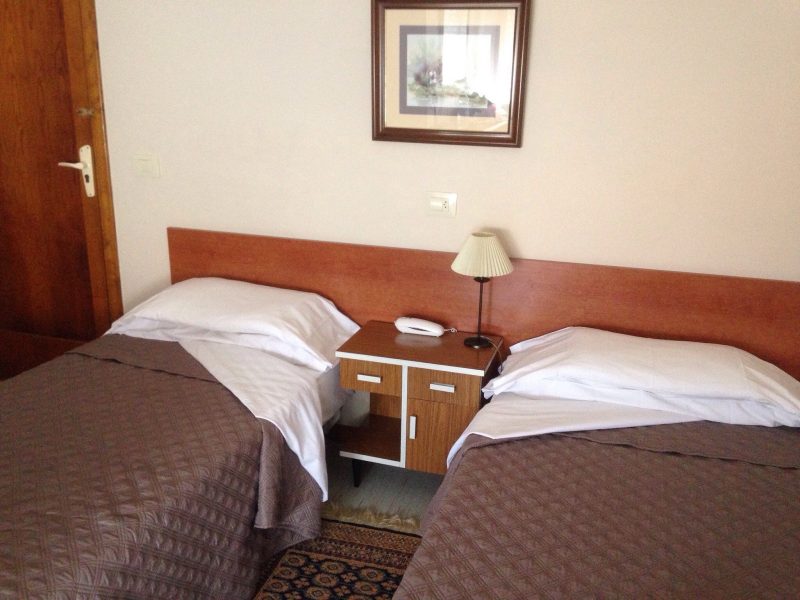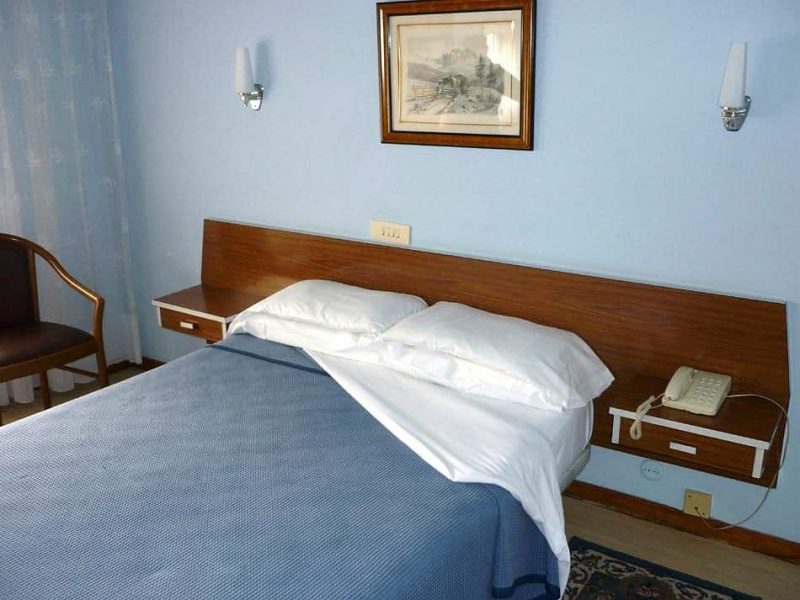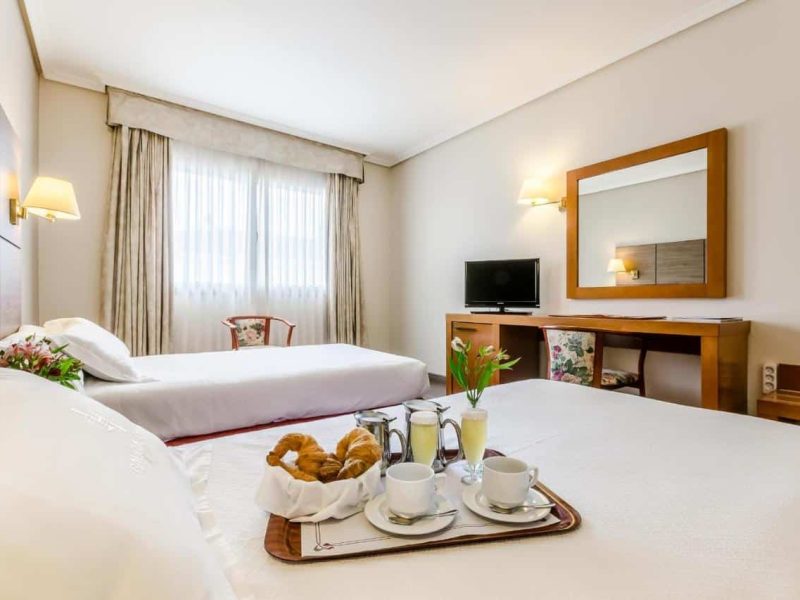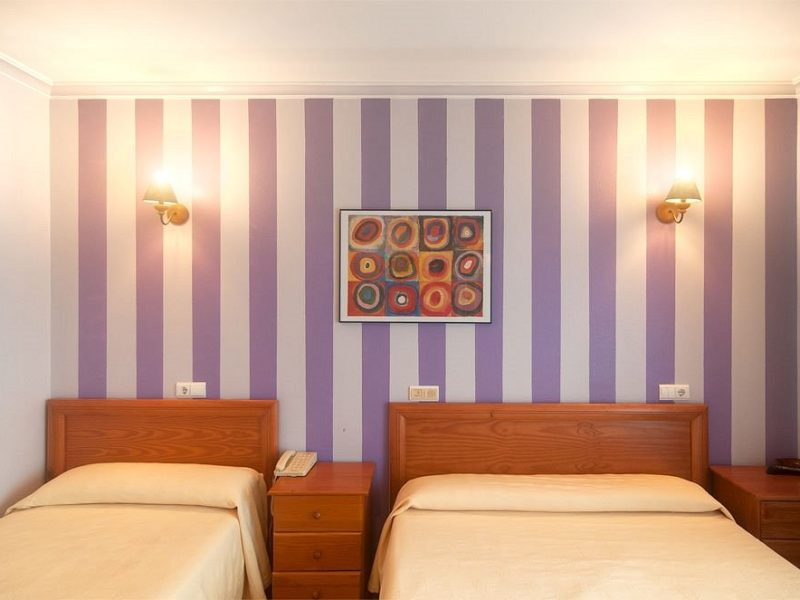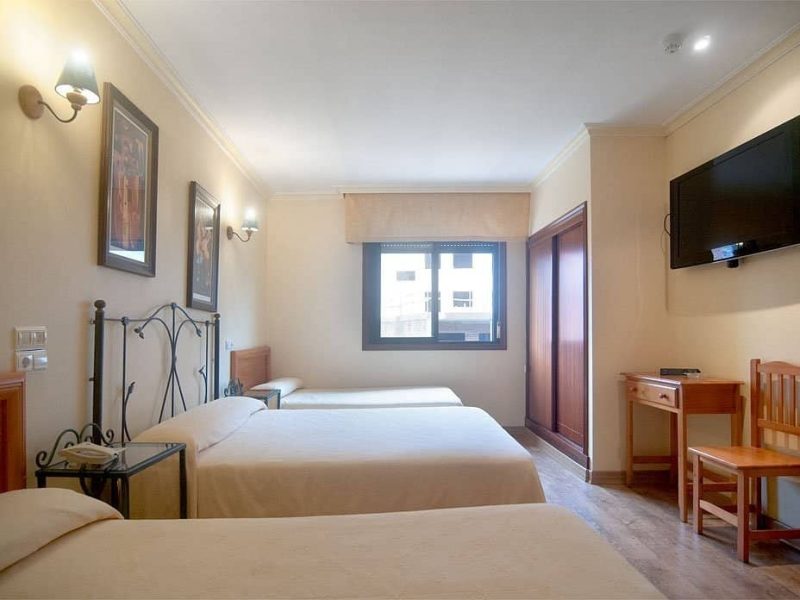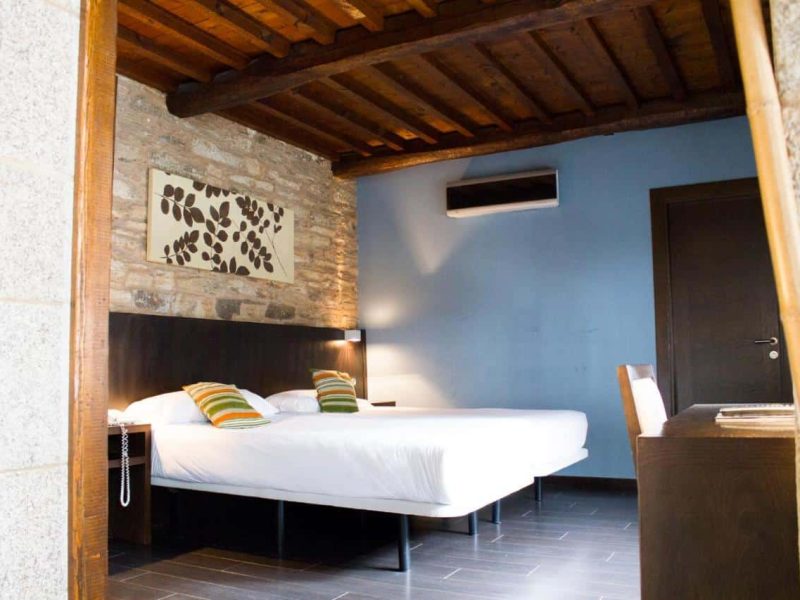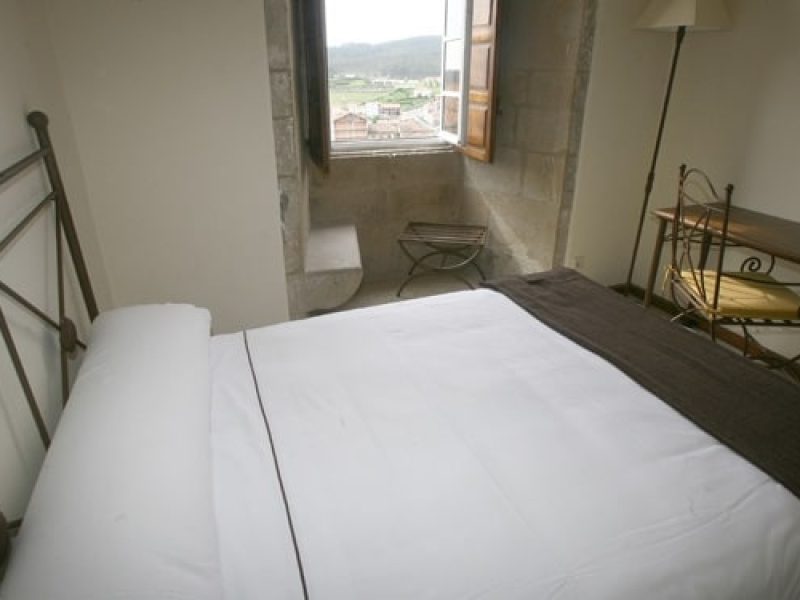Way from Tui to Santiago
Every great journey begins only with dreaming about it.
Discover the Way from Tui to Santiago
A unique journey
Way
The Camino de Santiago from Tui to Santiago has this town as its gateway to Spain from Portugal. In Galicia, this route of the Portuguese Way runs parallel to the Rías Bajas of Vigo and Pontevedra.
It is a journey we will complete in seven days, crossing lush landscapes with numerous rivers and wooded areas. Population centers with as much significance and architectural beauty as Redondela, Pontesampaio, Pontevedra, Caldas de Rei, and Padrón, where, according to legend, the boat carrying the remains of the Apostle from Palestine arrived.

More details
Origin
Tui

Destination
Santiago

Duration
7 days / 6 nights / 5 stages

Total Kms
116

Price / person
590€
Book now!
Indicates the number of persons

services
Services
Full and customizable services for a worry-free experience on the Wey of Santiago.
Services Included
Accommodations in Hotels, Manor Houses, Rural Houses, Hostels
Rooms with private bathroom.
Special breakfast
Travel assistance insurance in Spain
Roadside assistance vehicle in case of emergency
On-Route Telephone Assistance
Luggage transfer on the stages
✓ 1 suitcase per person, maximum 20Kgs
Special gifts, including the Pilgrim's Credential, the Pilgrim's Shell, and a Typical Galician Product.
No cancellation fees
✓ Up to 10 days before starting the Camino
IVA
Optional Services
Single room supplement
✓ Consult
Dinner supplement
✓ Consult
Extra night in Santiago
✓ Check the rate.
Split the Tui-Redondela Stage (2 stages)
✓ Consult.
Replace Caldas de Reis-Padrón Stage
✓ Hacer translatio (Boat + foot)
Additional baggage
✓ Check rate if you have more than 1 suitcase per person
1 Day Trips (Bus)
✓ Finisterre (Costa da morte) and/or Rias Baixas.
Cancellation Insurance
Remember that the cost of the optional services chosen will be added to the base price of your route. We are committed to making your pilgrimage an unforgettable and carefree experience. Welcome to the Wey!
Stages
Discover the Wey of Santiago towards the majestic Santiago de Compostela.
Day 1: Arrival in Tui. Lodging.
Welcome to the beginning of your journey. Get ready for an unforgettable adventure!
Day 2: Stage from Tui to Redondela (31.2 km)
- Duration: 8h
- Difficulty: Medium
Breakfast and start of the first stage of our Way from Tui to Santiago.
We begin this stage by crossing and strolling through the spectacular old town of Tui. We will have visited, among other monuments, the splendid Cathedral of Santa María de Tui, the Church of San Telmo, as well as the International Bridge designed following the influences of Eiffel.
The ways crosses paths and trails through extensive wooded areas and numerous watercourses. We will cross the Ponte da Veiga, over the Louro river, one of the most characteristic of the journey.
On the way to Redondela, we will visit the Pazo de Mos, Cruceiro Os Cabaleiros, and the Chapel of Santiaguiño.
Arrival in Redondela. End of the stage. Lodging.
RECOMMENDATION
For those with little physical preparation or who prefer to undertake the stage in a more calm and relaxed manner, it would be advisable to divide the stage into two days:
Stage from Tui to Porriño (16.4 km)
Stage from Porriño to Redondela (14.8 km)
Day 3: Stage from Redondela to Pontevedra (19.8 km)
- Duration: 5h
- Difficulty: Low
Breakfast and start of the stage.
Another stage of great beauty, intense green meadows, and magnificent views over the estuary of Vigo.
We will pass through numerous places that will invite us to stop.
It is worth noting in this stage the passage through Monte Albor and Pontecesures.
Among them, Arcade stands out, with its world-famous oysters, as well as Ponte Sampaio, famous for having hosted a battle against the French troops, which led to the retreat of Marshal Ney’s troops from Galician lands.
Arrival in Pontevedra. Lodging.
Day 4: Stage from Pontevedra to Caldas de Rei (21.9 km)
- Duration: 5h
- Difficulty: Low
Breakfast and start of the stage.
After visiting Pontevedra, with its historic center of great monumental value, as well as its numerous squares, this stage plunges us back into the most rural Galicia, with numerous small villages and isolated houses surrounded by areas of abundant vegetation.
We will travel through small ways and trails, until reaching our goal of the day, Caldas de Rei, famous for being a top-tier thermal village, where if the pilgrim wishes, they can enjoy its thermal waters.
Arrival in Caldas de Rei. End of the stage. Lodging.
Day 5: Stage from Caldas de Rei to Padrón (18.5 km)
- Duration: 5h
- Difficulty: Low
Breakfast and start of the stage.
Short and very comfortable stage. We continue crossing Galicia without major difficulties, with terrain that invites us to relaxation and meditation.
Small rural communities, numerous cruceiros (stone crosses) will appear along our way, mixed with the serene silence that has accompanied us since we began our Way of Saint James from Tui.
Arrival in Padrón. End of the stage. Lodging.
DID YOU KNOW that in Padrón, under the main altar lies “el Pedrón,” a stone said to have been used to tie the boat that transported the Apostle James, already dead, from Palestine to the Galician coasts.
Spiritual Variant-Translatio
There is the possibility of replacing this stage of the Camino de Santiago from Tui with a boat trip that runs from Vilanova de Arousa, through the Ría de Arousa, to the Ulla River, up to Pontecesures. From there, we will resume the journey on foot to Padrón (2.5 km).
Translatio–Translation that, according to legend, was made by the stone boat, with the remains of the Apostle James from Palestine to Iria Flavia (Padrón), along with his two disciples Anastasius and Theodore.
Day 6: Stage from Padrón to Santiago de Compostela (24.6 km)
- Duration: 5h
- Difficulty: Low
Breakfast and start of the stage.
After our stay in Padrón and Iria Flavia, places of great Jacobean evocation-according to legend, here the boat with the Apostle’s remains from Palestine ran aground on a “Pedrón”, which is preserved in the cathedral of that city, we head to the end of our Way.
This stage is not as spectacular as the previous ones, as there are many asphalted tracks, and the villages are no longer as bucolic.
Despite this, we are in an area where a large part of the legend of the Apostle’s “translatio” to Santiago de Compostela took place.
Arrival in Santiago de Compostela and end of our Camino de Santiago from Tui. Lodging.
If you prefer, as an alternative, you can take the Portuguese Way along the coast, which also enjoys great popularity.
Day 7: Breakfast
We’re coming to the last day of your trip! Enjoy breakfast and conclude this unforgettable experience with us. Thank you for being part of this adventure!
This itinerary will take you through the most popular stages, allowing you to experience the beauty and culture of the Wey of Santiago. Be sure to book accommodation in advance, as it can get crowded, especially in the high season.
Safe travels and buen Wey!
Lodging
In our constant effort to provide the best experience to our customers, we want to assure you that we are committed to your rest and comfort. The accommodations we offer have been carefully selected and provide private rooms with private bathrooms, along with all the necessary services to make the most of your stay. It is important to note that we will never put you up in hostels.
Since these accommodations have a limited capacity, we will provide you with the exact name once you confirm your reservation and we verify availability on the dates of your choice. Your satisfaction is our priority!

Frequently Asked Questions
What to eat and typical dishes on the Camino de Santiago from Tui to Santiago?
As in any type of journey, planning will always allow you to achieve favorable results, and on the Way of Santiago, this is no exception. Having an order in accommodations, hydration, and food will significantly help to make the most of your time and somehow avoid certain setbacks.
If you are walking the Portuguese Way, you should know that, in addition to beautiful landscapes, this particular route allows you to enjoy amazing gastronomy. Therefore, having a guide or recommendation will always be of great help.
Here we will talk about the most typical dishes you can find from Tui to Santiago. We will also take the opportunity to suggest some restaurants you can find along this stretch.
Typical dishes of this stretch (Pontevedra, A Coruña)
The general gastronomy of Galicia is one of the most traditional across the national scene. Of course, this region is subdivided into other areas which in turn diversify the pleasures for the palate. These are some of the typical dishes of the Portuguese Way, from Tui to Santiago de Compostela.
Angulas de Tui
Baby eels might seem a bit strange, especially if you come from afar. These are the fry of eels, which are also the only ones by law allowed to be fished in the region. In the rest of Spain, they are quite scarce and expensive. However, in this area, they are really affordable by the banks of the Miño.
They are available all year round, however, they are much more consumed in winter, during the fishing season. The way to prepare them is extremely simple. You just need olive oil, garlic, and chili pepper and always use clay pots.
Chocos en su tinta
This is another small-sized marine species. Also known as baby cuttlefish, chopitos, they are actually the offspring of the cuttlefish or squid. They are especially popular in the Redondela area, where they present an extremely high quality.
It is prepared with the cuttlefish’s own ink. It is accompanied by a stew made from garlic, tomato, onion, and red wine. These ingredients are integrated and then the chocos are cooked in it. Once they have reduced in size, they are served accompanied by rice and a good touch of aioli.
Pimientos de Padrón
Galicia is a region of peppers, but without a doubt, Padrón peppers are the most well-known, although they are also produced in areas like Dodro and Rois. They are small in size and olive green in color, although you can also find some yellowish ones.
A particularity is that some tend to be spicy, although discovering which ones is a complicated task. They are usually served as an appetizer or starter. The traditional way is to prepare them fried and accompany them with a beer.
Tarta de Santiago
Also known as Compostela cake. In fact, it is one of the most traditional desserts of all Galician cuisine. As you can imagine, it goes without saying that it is directly related to the pilgrimages that have been made in this area for hundreds of years.
It is consumed throughout the year, but especially during the month of July in the festivities of Galicia and Santiago.
It is made from ground almonds, butter or lard, sugar, eggs, and orange or lemon. As a curious fact, it does not contain flour, and records of the consumption of this preparation date back to 1577.
Where to eat from Tui to Santiago?
Best places to eat from Tui to Santiago
Between the stretch that goes from Tui to Santiago, there are a number of establishments that you must visit, as they represent tradition and good flavors. Among these, it’s worth mentioning:
Taperia O Alberigue (Tui)
Located at number six Seijas street in Tui, Taperia “O Albergue” is an establishment that anyone visiting the city must know and enjoy.
It’s a place to enjoy the best tapas in the region. These can be accompanied by a glass of wine, as their variety is quite wide, all from the area, of excellent quality. Furthermore, if you like to enjoy a more complete meal, they also offer a daily menu, with good prices and unmatched freshness.
Restaurante Bar La Cueva (Porriño)
If you like homemade flavors, this is definitely the right place for you. La Cueva is located at number 15 Rúa Ramón González in Porriño and is open to the public from Monday to Saturday.
Their specialty is undoubtedly the tripe. Although they are also famous for their pies, octopus, and of course, the tapas and sandwiches.
Their terrace is perfect for enjoying a glass of wine and some tapas in the late afternoon when the sun starts to set. However, at any time, you’re always going to find good and delicious options.
Pulperia Rial (Padrón)
Firstly, we must highlight that here you will always be treated as if you were family, so you will feel more than welcome. It is located at number 13 Traviesas square, in the center of Padrón, so it won’t be hard to get there.
The house specialty is octopus, although they also have a varied daily menu where Galician cuisine is the undisputed star.
Rua do Franco (Santiago de Compostela)
It’s one of the most emblematic streets of the city of Santiago de Compostela. Popularly known as El Franco, it is undoubtedly one of the main gastronomic and leisure avenues.
It is located within the historic center of Santiago. It leads directly to Plaza del Obradoiro and Plaza de Platerías. Regardless of the time or day of the week, it is always kept with a lot of movement. And this is surely the point of the whole way where the most pilgrims converge.
Here you can find a little bit of everything when it comes to eating options. The protagonists will always be the tapas bars, where good wines are not surprised. As we have already told you, the variety is so much that you will surely find one adapted to your tastes.
How to get to Tui
We provide you with various options on how to get to your organized Way of Santiago starting from the border city of Tui, which marks the minimum distance, if you walk the Way, of 100 kilometers to obtain the certificate of the “La Compostela”.
Option 1: Private car and leave the vehicle parked in Tui
Option 2: Bus
Santiago>Vigo>Tui
– From Santiago to Vigo with the company Monbus.
– From Vigo to Tui with the Atsa company.
Madrid>Vigo>Tui (There is no direct option)
– From Madrid to Vigo with the Avanzabus company
– From Vigo to Tui with the Atsa company.
Option 3: Train (Renfe) at Guillarei Station.
Option 4: Airplane
The nearest airports to Tui are Santiago and Vigo.
From here, there are two possibilities to get to Tui:
– By bus, option seen previously.
– Private transfer: pick-up at Santiago/Vigo airport and direct transfer to the hotel in Tui. Please ask us for the price of the service.
What to see and do on the Way from Tui
STAGE FROM TUI TO PORRIÑO AND REDONDELA
We start with the town of Tui, where the International Bridge over the Minho River, a mandatory crossing for pilgrims, stands out. The walled enclosure of the 17th and 18th centuries, the Cathedral of Santa María (mix of Romanesque and Gothic) as well as the Porta da Pía or Pescadería in the urban center. Between the Bridge and the historic center, we cannot miss the riverside walk along the Minho.
Redondela, located at the end of the Vigo estuary, from which the island of San Simón emerges. We can behold a Roman milestone welcoming the pilgrim as they pass through the town, as well as its two viaducts from the second half of the 19th century. Noteworthy are the pilgrims’ hostel, the Casa de Petán or Santa Teresa from the 17th century, the Church of Santiago, and the Convent of Vilavella.
STAGE FROM REDONDELA TO PONTEVEDRA
In Ponte Sampaio, its bridge with ten semi-circular arches stands out, as well as the Church of Santa María, of Romanesque origin from the 12th century.
In Pontevedra, the Ponte do Burgo, which pilgrims cross on their way out of the historic centre, stands out. In the old quarter, the Sanctuary of the Pilgrim Virgin, patron saint of the city, stands out, with a scallop-shaped floor plan; inside, the carvings of Santiago, San Roque and the Virgin in pilgrim’s habit stand out.
In the Ferreria square, which is entered through the Porta do Camiño, is located the Convent of San Francisco next to the Star square, with its Casa de Caras and the Castro Sampedro Gardens.
PONTEVEDRA-CALDAS DE REI STAGE
We start at the entrance of Caldas de Rei with the Church of Santa María, of Romanesque origin. The Church of Santo Tomas Becket, built in 1890, the Church of Santa Maria de Bemil, San Andrés de César, and San Esteban de Saiar, all of Romanesque origin.
One of the great attractions of the town is that it is bathed by the Umia and Bermaña rivers, which can be crossed by pilgrims thanks to their Roman bridges. Its waters have therapeutic properties, which is why there are numerous spas in the town. In the square, the public fountain known as Las Burgas stands out, which is a good place to stop and refresh in its medicinal waters.
STAGE FROM CALDAS DE REI TO PADRON
We delve into the eminently pilgrim city of Padrón, which some mark as the true kilometer 0 of all the itineraries of the Camino de Santiago, where we highlight the neoclassical-style Santiago Church from the 19th century. The seal of the church depicts the scene of the arrival of the body of Saint James at the port of Padrón. Below the main altar is “el Pedrón“, a stone said to have been used to tie the boat in which the Apostle Santiago, already dead, was transported from Palestine to the Galician coasts. It is, therefore, a symbol for many pilgrims.
The fountain of Carmen from the 16th century, next to the convent of Carmen.
The Church of Santa María de Hebrón, The Church of San Antonio de Hebrón.
The Collegiate Church of Iria Flavia.
The Hermitage of Santiaguiño. Its great attraction is to walk the Via Crucis of 136 steps to reach it. Inside is a stone image of the Saint, as well as a group of rocks where the Apostle preached. Below the Hermitage is the fountain that, according to tradition, sprang up after the Apostle struck the ground with his staff.
The Cruceiro de Fondo da Vila from the 15th century.
Highlighting the Santiago bridge and the Roman bridge.
The Espolón promenade is a good place for a leisurely stroll.
If you do not wish to undertake this stage of the Portuguese Way on foot, there is the possibility of doing it by boat “La translatio“, with other totally different places to visit.
The most traveled way by pilgrims
The Way of Saint James from Sarria to Santiago It is the most popular, traveled route and occupies the number 1 in the pilgrims who request it, followed closely by the Way from Tui that we have just seen in this section, which is a slightly less crowded route, on certain dates, than the one that starts in the town of Sarria.
What documentation is necessary to do the Camino from Tui?
To walk the Camino from Tui, you will need the Pilgrim’s Credential, which will allow you to access the hostels and stamp your journey at each stage. Additionally, this document is essential to obtain the Compostela upon arriving in Santiago. It is also recommended to carry your ID or passport, and if you are a foreigner, your health card or medical insurance.
Is it possible to obtain the Compostela when completing the Tui-Santiago section?
Yes, by walking the section from Tui to Santiago, you will meet the requirements to obtain the Compostela, the official certificate of completion for the Camino de Santiago. It is necessary to walk at least the last 100 kilometers on foot, and the section from Tui covers approximately 115 kilometers.
What to eat and typical dishes on the Camino de Santiago from Tui to Santiago?
As with any type of journey, planning will always lead to favorable results, and the Camino de Santiago is no exception. Being organized with accommodations, hydration, and food will greatly help you make the most of your time and avoid certain setbacks.
If you are walking the Portuguese Camino, you should know that in addition to beautiful landscapes, this particular route allows you to enjoy amazing cuisine. Therefore, having a guide or recommendations will always be very helpful.
Here we will talk about the most typical dishes you can find from Tui to Santiago. We will also suggest some restaurants you can find along this stretch.
Typical dishes of this stretch (Pontevedra, A Coruña)
The overall cuisine of Galicia is one of the most traditional in the entire national landscape. Of course, this region is subdivided into other areas that further diversify the pleasures for the palate. These are some of the typical dishes of the Portuguese Camino, from Tui to Santiago de Compostela.
Angulas from Tui
Angulas may seem a bit strange, especially if you are coming from afar. They are the young eels, which are the only ones legally allowed to be fished in the region. In the rest of Spain, they are quite rare and expensive. However, in this area, they are truly affordable due to the proximity of the Miño River.
They are available throughout the year; however, they are much more commonly consumed in winter, during the fishing season. The preparation is very simple. You only need olive oil, garlic, and chili pepper, and they are always cooked in clay pots.
Chocos in their ink
This is another small marine species, also known as “choquitos” or “chopitos,” and they are the young of the cuttlefish or sepia. They are especially popular in the Redondela area, where they are of very high quality.
They are cooked with the sepia’s own ink, accompanied by a stew made from garlic, tomato, onion, and red wine. These ingredients are combined, and the chocos are cooked in the mixture. Once they have reduced in size, they are served with rice and a generous amount of aioli.
Padrón peppers
Galicia is a region known for peppers, but without a doubt, Padrón peppers are the most famous, although they are also produced in areas such as Dodro and Rois. They are small and olive green in color, although some may have a yellowish hue.
A unique feature is that some tend to be spicy, although figuring out which ones can be a challenge. They are typically served as an appetizer or starter. The traditional way to prepare them is by frying and serving them with a beer.
Santiago cake
Also known as tarta compostelana, this is one of the most traditional desserts in all of Galician cuisine. As you might expect, it is directly linked to the pilgrimages that have taken place in this area for hundreds of years.
It is consumed throughout the year, but especially in July during the festivities of Galicia and Santiago.
It is made from ground almonds, butter or lard, sugar, eggs, and orange or lemon. Interestingly, it contains no flour, and records of its consumption date back to 1577.
Where to eat from Tui to Santiago?
Best places to eat from Tui to Santiago
Between the stretch from Tui to Santiago, there are a series of establishments that you must visit, as they represent tradition and great flavors. Among these, it is worth mentioning:
Taperia O Alberigue (Tui)
Located at number six on Seijas street in Tui, Taperia “O Albergue” is a place that everyone visiting the city should know and enjoy.
It is a place to enjoy the best tapas in the region. These can be accompanied by a glass of wine, as their variety is quite wide, all local and of excellent quality. Additionally, if you’d like to enjoy a more complete meal, they also offer a daily menu with good prices and incomparable freshness.
Restaurante Bar La Cueva (Porriño)
If you love homemade flavors, this is definitely the place for you. La Cueva is located at number 15 on Rúa Ramón González in Porriño and is open to the public from Monday to Saturday.
The specialty is undoubtedly the tripe. Although they are also famous for their empanadas, octopus, and of course, tapas and sandwiches.
Their terrace is perfect for enjoying a glass of wine and some tapas in the late afternoon when the sun begins to set. However, at any time, you’ll always find delicious and tasty options.
Pulperia Rial (Padrón)
First of all, we must highlight that here they will always treat you like family, so you will feel more than welcome. It is located at number 13 on Plaza Traviesas, in the center of Padrón, so it won’t be hard to find.
The house specialty is octopus, although they also offer a varied daily menu where Galician cuisine is the undisputed star.
Rua do Franco (Santiago de Compostela)
It is one of the most iconic streets in Santiago de Compostela. Known locally as El Franco, it is undoubtedly one of the main gastronomic and leisure streets.
It is located within the historic center of Santiago. It leads directly to Plaza del Obradoiro and Plaza de Platerías. Regardless of the hour or the day of the week, it is always bustling. This is probably the point along the entire Camino where the most pilgrims converge.
Here you can find all sorts of options when it comes to dining. The main focus will always be tapas bars, where great wines are always in abundance. As we’ve mentioned, the variety is so great that you’ll surely find one to suit your tastes.
Where to eat from Tui to Santiago?
Best places to eat from Tui to Santiago
Between the stretch from Tui to Santiago, there are several establishments you must visit as they represent tradition and great flavors. Among these, it is worth mentioning:
Taperia O Alberigue (Tui)
Located at number six Seijas Street in Tui, Taperia “O Albergue” is a place that everyone visiting the city should know and enjoy.
It is a spot to enjoy the best tapas in the region. These can be accompanied by a glass of wine, with a wide variety of local wines of excellent quality. Additionally, if you prefer a more complete meal, they also offer a daily menu, with good prices and unmatched freshness.
Restaurante Bar La Cueva (Porriño)
If you like homemade flavors, this is definitely the place for you. La Cueva is located at number 15 Rúa Ramón González Street in Porriño and is open to the public from Monday to Saturday.
The specialty is undoubtedly the tripe. They are also famous for their empanadas, octopus, and of course, tapas and sandwiches.
The terrace is perfect for enjoying a glass of wine and some tapas in the late afternoon, as the sun begins to set. However, you will always find good and delicious options at any time of the day.
Pulperia Rial (Padrón)
Firstly, it is important to highlight that here you will always be treated like family, so you will feel more than welcome. It is located at number 13 Traviesas Square, in the center of Padrón, so it will not be hard to find.
The house specialty is octopus, although they also offer a varied daily menu where Galician cuisine is the undisputed star.
Rua do Franco (Santiago de Compostela)
It is one of the most emblematic streets in Santiago de Compostela. Known locally as El Franco, it is undoubtedly one of the main gastronomic and leisure streets.
It is located within the historic center of Santiago. It leads directly to Plaza del Obradoiro and Platerías Square. Regardless of the time or day of the week, it is always bustling with activity. This is certainly the point on the Camino where the most pilgrims converge.
Here you can find a bit of everything when it comes to dining options. The highlights are always the tapas bars, where good wines are always present. As mentioned, the variety is so great that you are sure to find one that suits your tastes.
How to get to Tui
We provide you with various options for how to get to your organized Camino de Santiago starting from the border city of Tui, which marks the minimum distance of 100 km if you walk the Camino to obtain the “Compostela” certificate.
Option 1: Private Car and park the vehicle in Tui
Option 2: Bus
Santiago>Vigo>Tui
– From Santiago to Vigo with Monbus.
– From Vigo to Tui with Atsa.
Madrid>Vigo>Tui (No direct option)
– From Madrid to Vigo with Avanzabus
– From Vigo to Tui with Atsa.
Option 3: Train (Renfe) Guillarei Station.
Option 4: Airplane
The closest airports to Tui are Santiago and Vigo.
From here, there are two possibilities to get to Tui:
– By bus, as mentioned earlier.
– Private transfer: pickup at Santiago/Vigo airport and direct transfer to the hotel in Tui. Please contact us for the service rate.
What to See and Do on the Camino from Tui
Stage from Tui to Porriño and Redondela
We start with the town of Tui, where the International Bridge over the Minho River stands out, a must-pass for pilgrims. The walled enclosure from the 17th and 18th centuries, the Cathedral of Santa María (a mix of Romanesque and Gothic), as well as the Porta da Pía or Pescadería in the urban area. Between the bridge and the historic center, we cannot miss the riverside walk along the Minho.
Redondela, located at the end of the Vigo estuary, where the island of San Simón emerges. We can see a Roman milestone welcoming pilgrims as they pass through the town, as well as its two viaducts from the second half of the 19th century. The pilgrim hostel, the Casa de Petán or Santa Teresa from the 17th century, the Church of Santiago, and the Convent of Vilavella are notable.
Stage from Redondela to Pontevedra
In Ponte Sampaio, its ten-arched semicircular bridge stands out, as well as the Church of Santa María, of Romanesque origin from the 12th century.
In Pontevedra, the Ponte do Burgo is noteworthy, which pilgrims cross as they leave the historic center. In the old town, the Sanctuary of the Virgin Peregrina, the patroness of the city with a scallop shell plan, stands out; inside are the sculptures of Santiago, San Roque, and the Virgin with pilgrim habits.
In the Plaza de la Ferreria, which you enter through the Porta do Camiño, is the Convent of San Francisco next to the Plaza de la Estrella, with its Casa de Caras and the Gardens of Castro Sampedro.
Stage from Pontevedra to Caldas de Rei
We start at the entrance to Caldas de Rei with the Church of Santa María, of Romanesque origin. The Church of Santo Tomás Becket, built in 1890, the Church of Santa María de Bemil, San Andrés de César, and San Esteban de Saiar, all of Romanesque origin.
One of the town’s great attractions is that it is bathed by the rivers Umia and Bermaña, which pilgrims can cross thanks to their Roman bridges. Its waters have therapeutic properties, which is why there are many spas in the town. In the Plaza, the public fountain known as Las Burgas is notable, which is a good place to stop and refresh in its medicinal waters.
Stage from Caldas de Rei to Padrón
We enter the eminently pilgrim city of Padrón, which some mark as the true kilometer 0 of all the Camino de Santiago routes, where we highlight the Church of Santiago in the neoclassical style of the 19th century; the church seal shows the scene of the arrival of the body of Santiago at the port of Padrón. Under the high altar is “el Pedrón”, a stone said to have been used to tie the boat in which the apostle Santiago was transported, dead, from Palestine to the Galician coast. It is, therefore, a symbol for many pilgrims.
The 16th-century Fuente del Carmen, next to the convent of Carmen.
The Church of Santa María de Hebrón, The Church of San Antonio de Hebrón.
The Collegiate Church of Iria Flavia.
The Chapel of Santiaguiño. Its great attraction is to walk the Via Crucis of 136 steps to reach it. Inside is a stone image of the Saint, as well as a group of rocks where the Apostle preached. Under the Chapel is the spring that, according to tradition, sprang up after the apostle struck it with his staff.
The Cruceiro de Fondo da Vila from the 15th century.
Highlight the Santiago bridge and the Roman bridge.
The Espolón promenade is a good place to walk leisurely.
If you don’t want to do this stage on foot, the Camino Portugués offers the possibility of doing it by boat “La translatio“, with other places to visit.
Do you still have doubts about the Camino?
This video will give you a more detailed and visual look at what to expect on your adventure. Don’t miss it!




